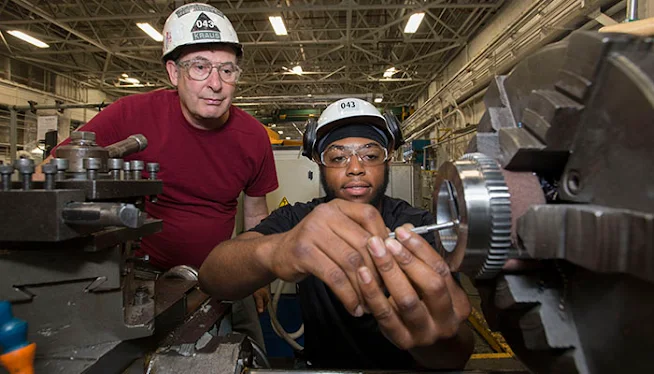So you're finishing high school and the world of career choices is sprawling before you. College? Sure, it's a great option, but the cost can be daunting, and the idea of spending years in lectures might not exactly spark your joy.
Maybe you're someone who thrives on hands-on learning, enjoys working with machinery, and appreciates the satisfaction of a job well done. If that sounds like you, then a career in the skilled trades, specifically millwrighting, could be an excellent fit!
Millwrights play a crucial role in keeping the wheels of industry turning. They're the mechanical masterminds behind the smooth operation of complex machinery in various sectors like manufacturing, power generation, and transportation. Imagine the colossal machines in a factory, the turbines at a power plant, or the intricate systems on a ship – millwrights are the ones who install, maintain, repair, and disassemble these vital components.
But let's get down to brass tacks – you're curious about the financial side of things. Is an apprenticeship a viable path to a good living? Absolutely! This blog post dives deep into the world of Apprentice Millwright Salaries in South Africa, giving you a clear picture of what to expect as you embark on this exciting career journey.
We'll explore average salaries, salary ranges based on different factors, and even touch on potential benefits and additional compensation. So, grab a wrench (metaphorically, for now), and let's get started!
1. Average Salary for Apprentice Millwrights
According to resources like Talent.com and the ERI Economic Research Institute, an apprentice millwright in South Africa can expect to earn an average annual salary of ZAR 168,000 (approximately USD 11,800). This translates to an average hourly rate of ZAR 86.15 (approximately USD 6.00).
1.1. Salary Range for Apprentice Millwrights
It's important to understand that the average salary is just a starting point. Apprentice millwright salaries can vary depending on several factors, including:
Location: Salaries tend to be higher in major cities and industrial hubs compared to rural areas.
Industry: Certain industries, like mining or power generation, may offer higher wages to attract qualified apprentices.
Company Size: Larger companies with more resources might offer more competitive salaries and benefits packages.
Experience Level: As apprentices gain experience and knowledge throughout their training program, their earning potential increases.
The salary range for apprentice millwrights typically falls between ZAR 105,750 (approximately USD 7,400) per year for entry-level positions and ZAR 600,036 (approximately USD 42,000) for more experienced apprentices nearing completion of their program.
Here's a table outlining some potential job titles and their typical salary ranges (based on South African data):
2. Benefits & Additional Compensation
Beyond the base salary, many employers offer benefits packages to their apprentices. These can include:
Health Insurance: This can help cover medical expenses, providing valuable financial security.
Paid Time Off: Apprentices may receive paid vacation days, sick leave, and personal days to allow for rest and personal time.
Retirement Savings Plans: Some employers might contribute to an apprentice's retirement account, promoting long-term financial planning.
Additional compensation can also come into play, such as:
Bonuses: Apprentices who consistently perform well or exceed expectations may be eligible for performance-based bonuses.
Overtime Pay: Working extra hours, especially during peak periods or for emergency repairs, can lead to overtime pay, increasing overall earnings.
3. Career Progression & Salary Growth
Upon successful completion of their apprenticeship, qualified millwrights can expect a significant salary increase. Journey-level millwrights typically earn considerably more than apprentices, with salaries varying based on experience, specialization, and the factors mentioned earlier.
For further information on career progression and salary expectations for qualified millwrights, resources like the South African Millwright Trade Union or industry-specific job boards can be valuable sources.
Conclusion
Becoming an apprentice millwright offers a promising career path with the potential for good wages and rewarding work. While the average apprentice salary provides a starting point, factors like location, industry, and experience can significantly impact earnings.
If you're interested in a hands-on career in the skilled trades and enjoy working with machinery, a millwright apprenticeship might be the perfect fit. Consider researching apprenticeship programs in your area, exploring industry resources, and connecting with qualified millwrights to gain further insights into this rewarding field.
Share your thoughts!
Have you considered a millwright apprenticeship? Do you have any experience with apprentice salaries in the skilled trades? Share your thoughts and experiences in the comments section below!

